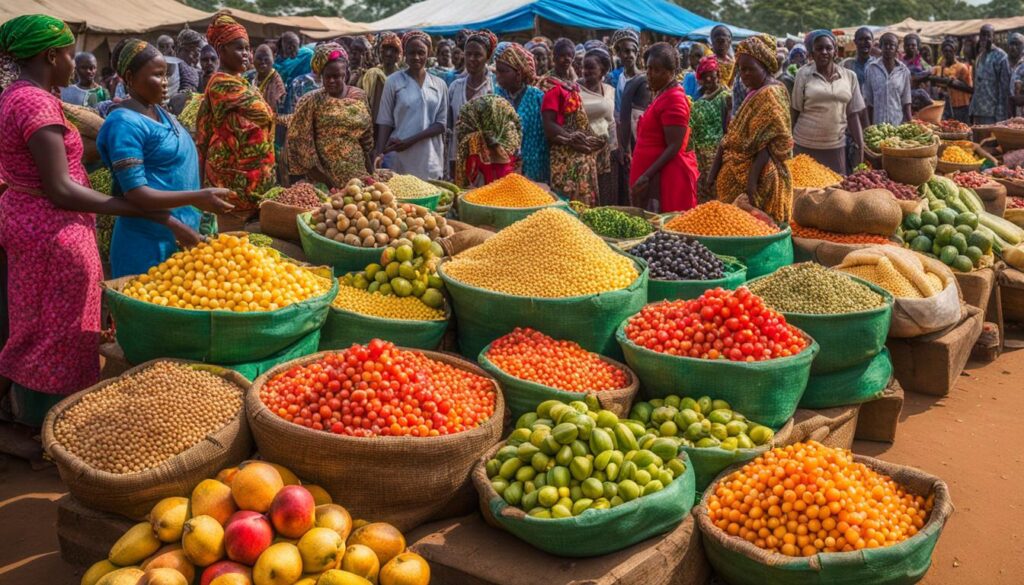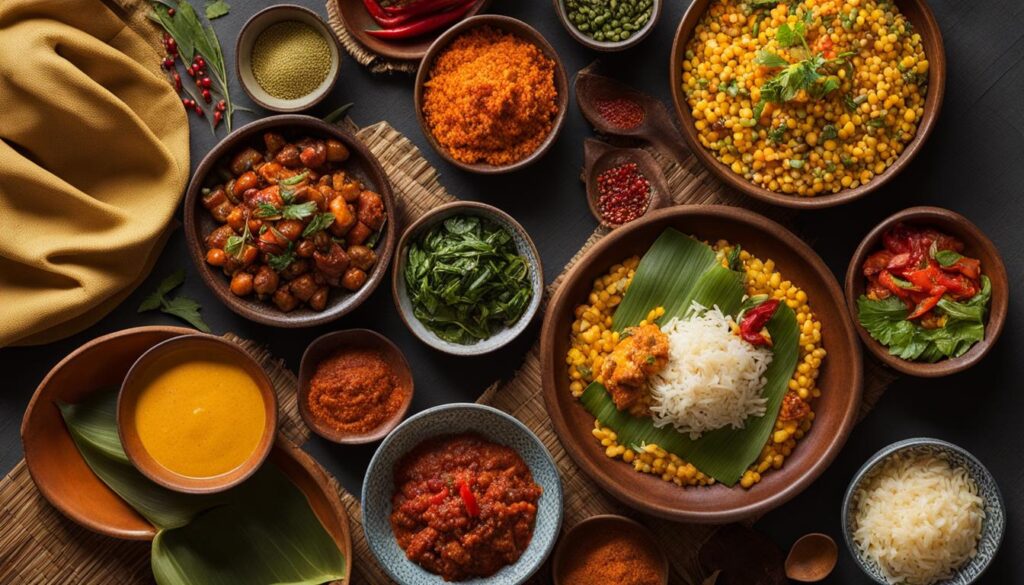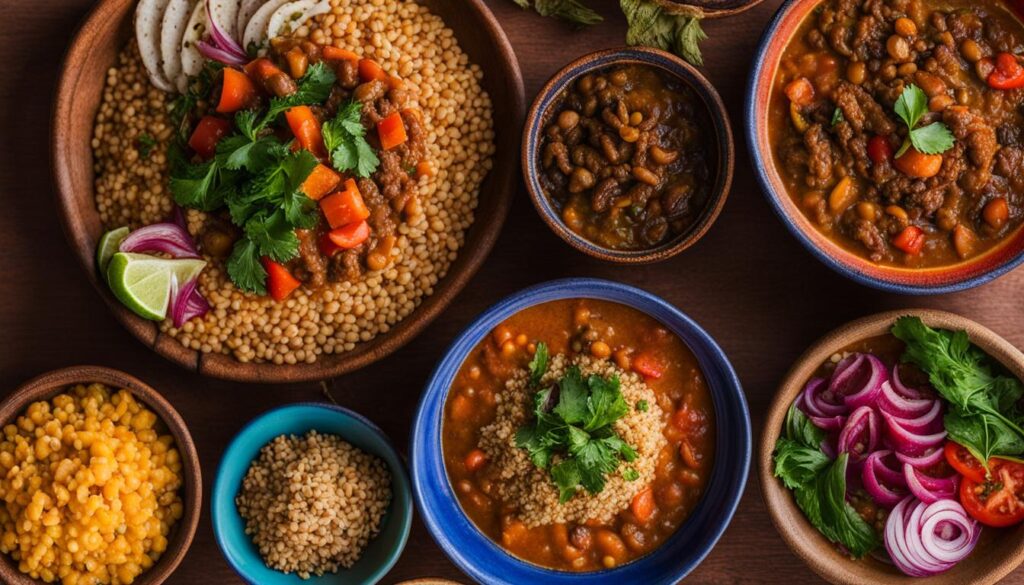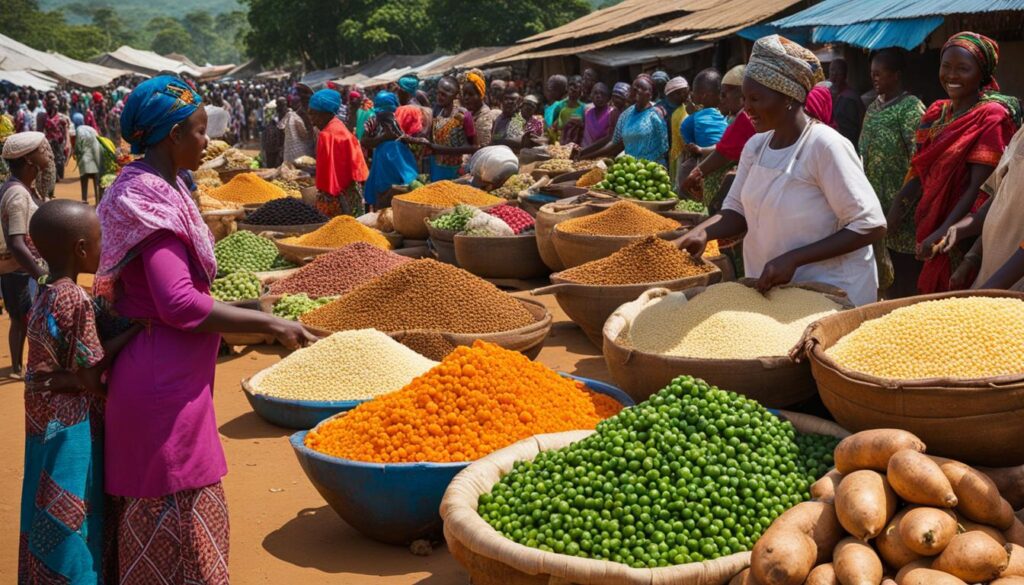Recent global price inflation has led to concerns over increasing hunger and malnutrition. A study by the Food and Agriculture Organisation (FAO) revealed that over three billion people worldwide cannot afford a healthy diet based on national food-based dietary guidelines. In Malawi, more than a third of children are stunted, and the population is projected to face increased hunger in the coming years. This article aims to delve into the past and present diets of Malawi, shedding light on the challenges faced and the impact on the country’s culture and health.
Key Takeaways:
- The affordability of food is a significant concern in Malawi
- Malawi has a rich culinary history with traditional foods playing a significant role in its culture and heritage
- The rise of processed foods in Malawi is contributing to non-communicable diseases
- Climate change is impacting Malawi’s food systems, leading to increased hunger and poverty
- Investing in sustainable food systems and addressing food affordability is crucial for combating hunger and malnutrition in Malawi.
The Cost and Affordability of a Healthy Diet in Malawi
Understanding the cost and affordability of food is crucial in addressing hunger and malnutrition in Malawi. According to the Food and Agriculture Organization (FAO), the average cost of a healthy diet globally in 2020 was USD 3.54 per person per day, which exceeds the international poverty line. In a study conducted by the World Food Program (WFP) in 2016, it was found that the cost of a basic plate of food in some regions of Malawi exceeded the daily income, highlighting the challenges faced by the poorest citizens in accessing nutritious meals.
The commercialization of food and the nutrition transition have contributed to the unaffordability of nutritious meals. As the country experiences economic slowdowns and rising food prices, the affordability of food becomes a significant concern. Finding sustainable solutions to improve food affordability is crucial for addressing hunger and malnutrition in Malawi.
“The cost of a basic plate of food often exceeds daily incomes in some regions, making it difficult for many Malawians to access nutritious meals,” says Dr. Grace Kamanga, a nutrition expert in Malawi.
Investing in sustainable food systems and supporting small-scale producers is one way to address the challenge of food affordability. By promoting sustainable agriculture and prioritizing access to sufficient, safe, and nutritious food for all Malawians, the country can work towards a healthier future for its population.

Traditional Foods of Malawi
Malawi has a rich culinary history, with traditional foods playing a significant role in its culture and heritage. Staples like maize and sorghum are still important in family eating. However, there has been an increase in the consumption of processed foods, such as sweetened beverages and snacks. Traditional Malawian dishes often include nsima (made from maize flour) and stew made from brown beans. These dishes are representative of a typical Malawian meal and are consumed across the country.
The traditional foods of Malawi offer a glimpse into the country’s cultural identity and food preferences. Nsima, a thick porridge-like dish made from maize flour, is a staple food in Malawian cuisine. It is often served alongside a variety of stews, such as the brown bean stew mentioned earlier. Other popular traditional dishes include chambo (a type of fish), kachumbari (a salad made with tomatoes, onions, and cilantro), and pumpkin leaves cooked with groundnuts.
Exploring the traditional foods of Malawi not only provides insights into the country’s culinary traditions but also highlights the importance of preserving and promoting these foods as part of a healthy and sustainable diet. By embracing and celebrating the rich diversity of Malawian cuisine, we can contribute to the preservation of cultural heritage and support local food systems.
The Role of Traditional Foods in Malawian Culture
Traditional foods hold a special place in the culture and heritage of Malawi. They are often prepared and shared during festive occasions and gatherings, strengthening social bonds and fostering a sense of community. They are also deeply connected to the land and the agricultural practices that have sustained the country for generations.
| Traditional Food | Description |
|---|---|
| Nsima | A thick porridge-like dish made from maize flour. It is typically served alongside stews and other dishes. |
| Chambo | A type of fish commonly found in Lake Malawi. It is often grilled or fried and served with nsima. |
| Kachumbari | A salad made with tomatoes, onions, and cilantro. It is a refreshing accompaniment to main dishes. |
| Pumpkin Leaves with Groundnuts | A nutritious dish made by cooking pumpkin leaves with groundnuts. It is often served as a side dish. |
Traditional foods play an essential role in maintaining our cultural identity and connecting us to our roots. By incorporating these foods into our daily meals, we not only support local farmers and food producers but also ensure that our traditions and heritage are passed down to future generations.” – Traditional Malawian Food Enthusiast
In conclusion, the traditional foods of Malawi offer a unique and flavorful culinary experience that reflects the country’s rich cultural heritage. These foods not only provide sustenance but also serve as a way to preserve tradition and foster a sense of community. By embracing and promoting traditional Malawian cuisine, we can celebrate the diversity and resilience of the country’s food culture while supporting local farmers and food producers.
Festive Foods in Malawi: A Culinary Delight
Malawi, known for its vibrant culture and rich culinary heritage, boasts a variety of festive foods that are celebrated and enjoyed throughout the year. These popular and famous foods not only bring joy and flavour to special occasions but also hold significant cultural and historical significance. From traditional dishes passed down through generations to modern creations incorporating local and global influences, Malawian festive foods offer a fascinating glimpse into the country’s diverse gastronomic traditions.

One such festive food is the mouthwatering “Nthochi,” a traditional dish often prepared during weddings, religious ceremonies, and other joyous occasions. This delectable treat consists of grilled fish, typically tilapia, seasoned with a blend of savoury spices and herbs. Nthochi is often served alongside staple foods like nsima, a maize-based porridge, and various relishes made from vegetables and legumes. Its robust flavours and vibrant presentation make it a beloved dish among Malawians and visitors alike.
“Nthochi is a true culinary masterpiece that showcases the skill and creativity of Malawian cooks. Its tantalizing aroma and burst of flavors make every bite a celebration of the country’s rich culinary heritage.” – Local Food Critic
Another festive food that holds a special place in Malawian culture is the “Mbatata Cake,” a sweet and indulgent dessert made from locally grown sweet potatoes. This delightful cake is often enjoyed during festivals, holidays, and special occasions. Its moist texture, subtle sweetness, and aromatic spices create a harmonious blend of flavours that perfectly capture the essence of Malawian cuisine.
In addition to these traditional delights, Malawi’s festive foods also embrace the influences of global cuisines. The country’s diverse population and cultural exchanges have introduced new culinary experiences, resulting in unique fusion dishes that reflect a vibrant blend of flavours and traditions. These innovative creations, such as the “Chipsima,” a fusion of fries and nsima, offer a fresh perspective on Malawian cuisine and highlight the country’s evolving culinary landscape.
| Festive Food | Description |
|---|---|
| Nthochi | Grilled fish with savoury spices and herbs, served with nsima and relishes |
| Mbatata Cake | Sweet potato cake with a moist texture, subtle sweetness, and aromatic spices |
| Chipsima | A fusion of fries and nsima, representing the fusion of global and local influences |
The Impact of Climate Change on Malawian Food Systems
Climate change poses significant challenges to Malawi’s agriculture and food systems, with far-reaching implications for the availability and affordability of food. The country has experienced more frequent and severe climate-related events, such as droughts and floods, which have disrupted agricultural production and led to crop failures. These climate shocks, combined with economic slowdowns and rising food prices, have increased hunger and poverty among the population.
In addition to climate-related challenges, Malawi’s population growth and increasing demand for food and dietary diversity further strain the already vulnerable food systems. With limited resources and infrastructure, the country faces significant barriers in ensuring food security for its people.

Adapting to climate change and building resilient food systems require concerted efforts and holistic approaches. Malawi needs to invest in sustainable agricultural practices that conserve natural resources, promote climate-smart farming techniques, and enhance the resilience of small-scale farmers. Diversifying crops and promoting more resilient varieties can help mitigate the risks posed by climate change.
Furthermore, enhancing access to market information, credit facilities, and agricultural extension services can empower farmers to make informed decisions and adopt climate-resilient practices. Strengthening social safety nets and implementing targeted interventions to support vulnerable populations in times of climate-related crises are crucial for building resilience.
| Impacts of Climate Change on Malawian Food Systems | Key Strategies to Address Climate Change Challenges |
|---|---|
| Increased frequency and severity of climate-related events | Promote sustainable agricultural practices |
| Disrupted agricultural production and crop failures | Advocate for climate-smart farming techniques |
| Rising food prices and increased hunger | Diversify crops and promote resilient varieties |
| Inadequate resources and infrastructure | Enhance access to market information and credit facilities |
| Population growth and demand for food | Strengthen social safety nets and targeted interventions |
Democratizing the Exploration of Malawian Eating Habits
To gain a deeper understanding of Malawian eating habits and their impact on public health, a photovoice study was conducted in a semi-rural district of Blantyre. The study involved four families, with younger members using smartphones to document their daily meals, focusing on breakfast, lunch, and dinner. Through thematic analysis of the photos and subsequent focus group discussions, valuable insights were gained into the traditional and contemporary food choices in Malawi.
The findings revealed that staple foods like maize and sorghum continue to hold significant importance in Malawian diets. These traditional foods are consumed across the country and reflect the cultural identity and food preferences of the population. However, there has been a noticeable increase in the consumption of processed foods, which are often high in sugar, salt, and unhealthy fats. The rise of obesogenic processed foods poses a considerable challenge to public health, as it contributes to the prevalence of non-communicable diseases like diabetes.
By employing co-designed research methodologies like photovoice, this study aims to democratize the exploration of Malawian eating habits. It empowers communities to take an active role in shaping their own health outcomes and fosters a better understanding of the complex relationship between diet and public health. By understanding the dietary patterns and challenges faced by the population, policymakers and stakeholders can develop contextually specific strategies and interventions to promote healthier eating habits and combat the rising burden of non-communicable diseases in Malawi.

The Role of Traditional Foods
Traditional Malawian dishes, such as nsima (made from maize flour) and stew made from brown beans, are an integral part of the Malawian meal. These dishes not only provide sustenance but also carry cultural significance. They represent the shared heritage and traditions of the Malawian people. However, as the country undergoes a nutritional transition, it is crucial to strike a balance between preserving traditional food practices and adapting to the changing food landscape. This study sheds light on the need for informed decision-making and effective policies that promote healthier eating habits while respecting and preserving Malawi’s rich food culture.
Addressing the Challenge of Food Affordability in Malawi
Food affordability poses a significant challenge in Malawi, particularly for the country’s poorest citizens. In some regions, the cost of a basic plate of food exceeds the daily incomes of many individuals. This unaffordability has adverse effects on nutrition and contributes to the prevalence of malnutrition and hunger in the country. It is crucial to develop strategies that tackle this issue head-on and prioritize access to sufficient and nutritious food for all Malawians.
The commercialization of food and the nutrition transition also play a role in the affordability challenge. The increased consumption of processed foods, which are often more expensive than traditional staples, further exacerbates the problem. This shift in dietary patterns not only affects the affordability of meals but also contributes to the rise of non-communicable diseases in Malawi.
To address the challenge of food affordability, policymakers and stakeholders must prioritize sustainable agriculture and support small-scale producers. Investing in these areas can help create a more resilient food system that ensures affordable and nutritious food is accessible to all. Additionally, promoting local food production, implementing market-based interventions, and improving transportation infrastructure can aid in reducing food prices and improving affordability.
| Strategies to Address Food Affordability in Malawi | Key Benefits |
|---|---|
| Promoting sustainable agriculture and supporting small-scale producers | – Enhances local food production and reduces reliance on expensive imported goods |
| Implementing market-based interventions | – Encourages competition, leading to lower food prices |
| Improving transportation infrastructure | – Reduces transportation costs, making food more affordable |
By addressing the challenge of food affordability, Malawi can make significant progress in combating hunger and malnutrition, improving the overall health and well-being of its population. It is essential for policymakers and stakeholders to collaborate and prioritize interventions that promote affordable, safe, and nutritious food for all Malawians.

Investing in Sustainable Food Systems in Malawi
Investing in sustainable food systems is crucial for addressing the challenges faced by Malawi in terms of food affordability, nutrition transition, and climate change impacts. It requires targeted investments and policy decisions that encompass various aspects, including poverty alleviation, improving access to nutritious food, and mitigating the effects of climate change. By adopting a comprehensive approach, Malawi can work towards a future where its population has access to sufficient, safe, and nutritious food.
One key aspect of investing in sustainable food systems is doubling the income of small-scale producers. Small-scale farmers play a vital role in the country’s food production, but they often face financial constraints that hinder their productivity. By providing support and resources to these farmers, such as training, access to credit, and improved market opportunities, they can increase their income and contribute to sustainable agriculture in Malawi.
The transition to healthier diets is another important component of sustainable food systems. Educating the population about the importance of nutritious foods and promoting the consumption of traditional and locally sourced ingredients can have a significant impact on public health. By encouraging the consumption of Malawian recipes and traditional food dishes, the country can not only improve the health of its population but also preserve its cultural heritage.
Table: Key Factors for Investing in Sustainable Food Systems in Malawi
| Factors | Description |
|---|---|
| Doubling the income of small-scale producers | Providing support and resources to small-scale farmers to increase their income and contribute to sustainable agriculture |
| Promoting healthier diets | Educating the population about the importance of nutritious foods and encouraging the consumption of traditional and locally sourced ingredients |
| Investing in climate change adaptation | Implementing strategies to mitigate the effects of climate change on agriculture and food systems |
| Collaborating with decision-makers and donors | Engaging with policymakers and the donor community to secure investments and support for sustainable food systems |
Lastly, investing in climate change adaptation is crucial for ensuring the long-term sustainability of Malawi’s food systems. Climate-related events have a significant impact on the availability and affordability of food, as well as the livelihoods of farmers. By implementing strategies like water conservation, agroforestry, and the promotion of climate-resilient crops, Malawi can enhance its resilience to climate change and secure its food supply in the face of increasing environmental challenges.
To support the transition to sustainable food systems in Malawi, it is essential for country-level decision-makers and the donor community to be equipped with evidence-based insights. Through research, consultations with stakeholders, and economic modelling, valuable information can be generated to inform policy decisions and investments. By adopting a collaborative and evidence-based approach, Malawi can create sustainable and equitable food systems that address the challenges of hunger, malnutrition, and climate change in the country.

Conclusion
The past and present diets of Malawi reflect the challenges faced by the country in terms of food affordability, nutrition transition, and climate change impacts. Traditional foods still play an essential role in Malawian cuisine, but the rise of processed foods is contributing to non-communicable diseases. Understanding the link between diet and health is crucial for developing effective prevention strategies.
Additionally, addressing the affordability of food and investing in sustainable food systems are key to combating hunger and malnutrition in Malawi. By prioritising access to nutritious and affordable food, the country can work towards a healthier future for its population.
In conclusion, Malawi must embrace its rich culinary heritage by promoting traditional recipes and dishes that are both nutritious and culturally significant. At the same time, efforts should be made to reduce the consumption of processed foods and increase the affordability of healthy meals for all citizens. By prioritising sustainable and equitable food systems, Malawi can take significant steps towards overcoming the challenges of hunger, malnutrition, and climate change, ultimately improving the health and well-being of its people.
FAQ
What are the challenges faced by Malawi in terms of food affordability and nutrition?
Malawi faces challenges in terms of food affordability, with the cost of a basic plate of food often exceeding daily incomes in certain regions. Additionally, the commercialization of food and nutrition transition has contributed to the unaffordability of nutritious meals.
What are the traditional foods of Malawi?
Traditional Malawian dishes include staples like maize and sorghum, which are still important in family eating. Nsima, made from maize flour, and stew made from brown beans are representative of a typical Malawian meal and are consumed across the country.
How are changing diets in Malawi impacting noncommunicable diseases?
The “nutritional transition” in Malawi, characterized by the increase in consumption of obesogenic processed foods, has contributed to the rise of non-communicable diseases (NCDs) like diabetes. Dietary changes and nutrition transition are identified as key drivers of NCDs in the country.
What impact does climate change have on Malawian food systems?
Climate change has a significant impact on Malawian food systems. Climate-related events, economic slowdowns, and rising food prices have increased hunger and poverty in the country. The availability and affordability of food are affected by climate change, exacerbating the challenges faced by Malawi’s agriculture and food systems.
How is research being conducted on Malawian eating habits?
To understand the link between eating habits and public health issues like diabetes, a photovoice study was conducted in Malawi. Four families participated in the study, documenting their daily meals through smartphones. This study highlights the importance of co-designed research methodologies to empower communities and shape their own health outcomes.
What is being done to address the challenge of food affordability in Malawi?
To address the challenge of food affordability, strategies are being developed to improve access to nutritious and affordable food. This includes promoting sustainable agriculture, supporting small-scale producers, and developing policies that prioritize access to sufficient, safe, and nutritious food for all Malawians.
How is Malawi investing in sustainable food systems?
Achieving sustainable food systems in Malawi requires targeted investments and policy decisions. This involves doubling the income of small-scale producers, transitioning to healthier diets, and investing in climate change adaptation. Evidence-based research, consultations with stakeholders, and economic modelling are being used to inform decisions and create sustainable and equitable food systems in the country.
What are the key takeaways from exploring the past and present diets of Malawi?
The past and present diets of Malawi reflect the challenges faced by the country in terms of food affordability, nutrition transition, and climate change impacts. Understanding the link between diet and health is crucial for developing effective prevention strategies. Additionally, addressing the affordability of food and investing in sustainable food systems are key to combating hunger and malnutrition in Malawi.
Source Links
- https://www.frontiersin.org/articles/10.3389/fsufs.2023.1155661
- https://ojs.aut.ac.nz/rangahau-aranga/article/download/140/127/
- https://www.iisd.org/publications/report/sustainable-food-systems-global-crisis-malawi



